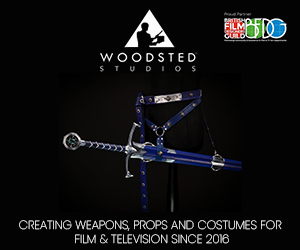Broadcast News
16/04/2018
How Micro-Narrative Structures Optimise Engagement In Movies

This article will be useful to screenwriters and filmmakers in understanding the science of how audiences engage with specific narrative structures. It will explain how suspense micro-narratives in feature films optimise audience engagement in 3-5-part story structures.
I will discuss key highlights from a 5-year empirical study of suspense and audience engagement. The outcomes discussed include: how suspense micro-narratives engage audiences in different ways; why the right balance of story information (concealed, delayed, revealed) is essential to develop empathy, suspense, and engagement; how we experience suspense on repeat viewing and which suspense micro-narratives structures elicit prolonged intense suspense and others a rapid form of suspense to heighten engagement.
The study tests Susan Smith's suspense narrative model (see part 1), via a film experiment to see how it optimises suspense and engagement. A mixed methods approach was taken triangulating three data sets: textual analysis of the filmmakers' intentions to engage the audience, recording viewer anxiety (electrodermal activity) and viewer self-reports to contextualise their subjective experience.
Suspense Narrative Model
Susan Smith's suspense narrative model fits within Brewer & Lichtenstein's suspense event cause-and-effect structure and offer different ways the viewer is positioned (POV) in relation to the frame and fictional characters. The study focuses on Smith's suspense micro-narrative structures vicarious, direct and shared and how they operate side by side as a composite form of suspense.
Vicarious suspense is when the viewer is privileged with information about a fictional character's (usually the protagonist) situation that they themselves are unaware of.
Direct suspense is essentially where the viewer experiences suspense alone rather than through an emotional bond with a character. From a narrative perspective, direct suspense is when the (POV) camera shot is seen in the first person and the viewer experiences suspense directly. Direct suspense may also operate by triggering a surprise event structure to trigger a suspenseful sequence.
Shared suspense is when the viewer and character(s) (usually the protagonist) share a similar emotional response when the protagonist experiences a conflict-crisis. These story events optimise audience engagement by inviting the viewer to empathise with the protagonist because they want them to overcome their conflict-crisis. Although shared suspense can construct suspense in a few seconds like vicarious and direct suspense, shared suspense can develop during longer sections of a film and is more commonly used in feature films than vicarious and direct suspense. This is because vicarious and direct suspense create a rapid form of suspense and are used to heighten suspense in a scene or short film sequence.
Composite suspense is when these three suspense micro-narrative structures work alongside each other. Vicarious, direct and shared can also work briefly at the same time creating a hybrid form of suspense. Vicarious, direct and shared suspense film clips in the study had a duration of 1.0-60.0 seconds, which indicates that these narrative structures appear at different times during the 3/5-part story structures, operating at a micro level (scene or movie sequence) and therefore can be classified as micro-narrative structures.
Film Experiment
In the study, viewers watched 32 film clips extracted from eight horror-thriller films. Film clip duration was determined by its suspense narrative structure (vicarious, direct, shared and composite) and story cause-and-effect paradigm. With the film clip duration being 1.0-90.0 seconds, we anticipated that the study would reveal how important the relationship is between suspense micro-narrative structures and audience engagement. We determined suspense as an anxiety response to a threatening stimuli presented in the film clips and we measured viewer physiological experiences of suspense as an anxiety response in terms of durability (duration) and intensity (level).
We can track the fear-anxiety process from neural messages of the brain to electrodermal activity. Psychologist René Misslin explains when we experience a threatening stimulus, the brain’s fear response centre (amygdala) in the limbic system of the brain instinctively mobilises the sympathetic nervous system and fight-flight body defence system (Misslin, 2003). Through a neural network consisting of the hypothalamus, brain stem, sympathetic nervous system and eccrine sweat glands, electrical changes are produced in the skin (electrodermal activity) - emotional sweating (Knight, et al., 2005). Therefore, we selected the psychophysiological recording technique, electrodermal activity (EDA) to measure anxiety in terms of durability (duration) and intensity (level).
Research Outcomes: Highlights
Rapid Forms of Suspense
Shorter narrative durations of vicarious and direct suspense film clips produced a higher frequency rate of anxiety responses than the longer film clips of shared and composite suspense. This informs us that shorter film clips have a more condensed threatening stimulus within the story context than the longer narrative structures of shared and composite suspense. Consequently, vicarious and direct suspense potentially are more likely to produce a rapid form of suspense to heighten engagement in a scene compared to shared and composite suspense.
Strongest Form of Suspense
When considering viewer anxiety responses across all micro-narrative structures, vicarious suspense was the most successful in producing a prolonged anxiety response at the highest level of intensity with 21.3% of the total, compared to 14.1% shared, 12.5% composite and 11.2% direct. Vicarious suspense also had the lowest percentage of the weakest anxiety responses at 23.8%, compared to composite 29.4%, shared 30.5% and direct suspense 32.5%.
Based on these findings vicarious suspense was less likely to produce a weak form of anxiety compared to direct, shared and composite suspense. These findings also indicate direct suspense produced the weakest form of suspense because they generated the least strongest anxiety responses and the highest weakest anxiety responses. This was mainly due to direct suspense film clips acting as a surprise story event to trigger a suspense sequence which was not present in vicarious or shared suspense.
Repeat Viewing
77.7% of repeat viewers (viewers who had seen the films before) reacted with the most strongest anxiety responses during vicarious suspense film clips. Direct, shared and composite suspense narrative structures also elicited anxiety responses on repeat viewing but only intermittently. This demonstrates that viewers were also more susceptible to react to a threatening stimulus in horror-thriller films on repeat viewings, which contradicts assumptions made by film theorists that because the cognitive state of uncertainty is essential for suspense to occur, viewers cannot experience suspense on repeat viewing.
Balance of Story Information
These findings provide evidence to support Alfred Hitchcock's assumption that vicarious suspense is the most effective suspense micro-narrative structure to generate a strong anxiety response. Even so, the success of these narrative structures was dependant on how story information was concealed, delayed or revealed to viewers, specific characters or both. In some instances, we found that viewers responded differently in terms of anxiety durability (time) and intensity (levels) to the same threatening stimuli. Although, when the right balance between revealing, concealing and delaying story information was achieved audience attention was optimised across all viewers.
For example, when the plot conceals the identity and location of the antagonist, viewer suspense is constructed by playing on viewers' imagination and fears about the antagonist. For instance, in 'Silent House' viewers were anxious about not only discovering the antagonist's identity but also that the antagonist would surprise them by jumping up in front of them on screen and scaring them.
Alternatively, 'The Descent' provides a good example of how concealing narrative information can also have a serious impact on story comprehension, suspense, and engagement. In this case, it was through an excessive use of jump cuts, which produced a defective fabula (story), causing viewers to feel disorientated and making it difficult for them to understand what was going on in the story world.
However, when plot development conceals narrative information, such as the antagonist's identity, then this produces high levels of anxiety and a sustained form of suspense as shown in Quarantine vicarious and Silent House composite suspense.
Interestingly, this finding contradicts Alfred Hitchcock's assumption that the viewer must always have all the facts for suspense to occur: "In the usual form of suspense it is indispensable that the public be made perfectly aware of all of the facts involved. Otherwise, there is no suspense" ('In Truffaut', 1985).
Empathetic Connection
When considering the popular film theory that the construction of suspense is generated by the viewer empathising with a liked fictional character whose life is threatened by an antagonist (Smith, S. 2000; Zillmann, 1994), Quarantine and Silent House developed a strong empathetic response for the protagonist in different ways. Quarantine used a hybrid form of vicarious-shared suspense to create a strong empathetic response with the protagonist. Whereas Silent House used a hybrid form of vicarious-direct suspense combined with a composite comprising of vicarious, direct and shared suspense working alongside each other. When considering viewers comments which explicitly stated that they empathised with the protagonist, Quarantine vicarious suspense achieved the highest score with Silent House composite suspense having the second highest score. While The Descent shared suspense had the lowest score in that viewers did not mention they empathised with either one or both female characters in the film clip.
Revealing Filmmakers Narrative Blind Spots
Anxiety responses could be matched to audio-visual stimuli in the story structure by millisecond accuracy so that it was possible to determine what threatening stimuli increased, sustained or decreased anxiety. Even though the study found specific suspense micro-narrative structures produced a strong anxiety response in terms of durability and intensity consistently across viewers, the study also revealed filmmakers' 'narrative blind spots' when the balance of information was out of sync - decreasing audience engagement.
This was determined by viewer self-reports and when a suspense micro-narrative structure stopped producing anxiety responses. With filmmakers relying on optimising viewer engagement through creative assumptions and conventions they have no way of knowing whether they have created any 'narrative blind spots'.
Direct, shared and composite suspense were more likely to produce filmmakers' 'narrative blind spots' than vicarious suspense, which consistently delivered a strong anxiety response in viewers even though it cannot produce an empathic response because the fictional character is unaware they are in any danger. This informs us that strong anxiety responses are more likely to occur when the protagonist is in a vulnerable life-threatening situation, with viewers anxiety driven by the fact they cannot warn of help the protagonist.
By Dr Keith Bound, Receptive Cinema
www.receptivecinema.com
I will discuss key highlights from a 5-year empirical study of suspense and audience engagement. The outcomes discussed include: how suspense micro-narratives engage audiences in different ways; why the right balance of story information (concealed, delayed, revealed) is essential to develop empathy, suspense, and engagement; how we experience suspense on repeat viewing and which suspense micro-narratives structures elicit prolonged intense suspense and others a rapid form of suspense to heighten engagement.
The study tests Susan Smith's suspense narrative model (see part 1), via a film experiment to see how it optimises suspense and engagement. A mixed methods approach was taken triangulating three data sets: textual analysis of the filmmakers' intentions to engage the audience, recording viewer anxiety (electrodermal activity) and viewer self-reports to contextualise their subjective experience.
Suspense Narrative Model
Susan Smith's suspense narrative model fits within Brewer & Lichtenstein's suspense event cause-and-effect structure and offer different ways the viewer is positioned (POV) in relation to the frame and fictional characters. The study focuses on Smith's suspense micro-narrative structures vicarious, direct and shared and how they operate side by side as a composite form of suspense.
Vicarious suspense is when the viewer is privileged with information about a fictional character's (usually the protagonist) situation that they themselves are unaware of.
Direct suspense is essentially where the viewer experiences suspense alone rather than through an emotional bond with a character. From a narrative perspective, direct suspense is when the (POV) camera shot is seen in the first person and the viewer experiences suspense directly. Direct suspense may also operate by triggering a surprise event structure to trigger a suspenseful sequence.
Shared suspense is when the viewer and character(s) (usually the protagonist) share a similar emotional response when the protagonist experiences a conflict-crisis. These story events optimise audience engagement by inviting the viewer to empathise with the protagonist because they want them to overcome their conflict-crisis. Although shared suspense can construct suspense in a few seconds like vicarious and direct suspense, shared suspense can develop during longer sections of a film and is more commonly used in feature films than vicarious and direct suspense. This is because vicarious and direct suspense create a rapid form of suspense and are used to heighten suspense in a scene or short film sequence.
Composite suspense is when these three suspense micro-narrative structures work alongside each other. Vicarious, direct and shared can also work briefly at the same time creating a hybrid form of suspense. Vicarious, direct and shared suspense film clips in the study had a duration of 1.0-60.0 seconds, which indicates that these narrative structures appear at different times during the 3/5-part story structures, operating at a micro level (scene or movie sequence) and therefore can be classified as micro-narrative structures.
Film Experiment
In the study, viewers watched 32 film clips extracted from eight horror-thriller films. Film clip duration was determined by its suspense narrative structure (vicarious, direct, shared and composite) and story cause-and-effect paradigm. With the film clip duration being 1.0-90.0 seconds, we anticipated that the study would reveal how important the relationship is between suspense micro-narrative structures and audience engagement. We determined suspense as an anxiety response to a threatening stimuli presented in the film clips and we measured viewer physiological experiences of suspense as an anxiety response in terms of durability (duration) and intensity (level).
We can track the fear-anxiety process from neural messages of the brain to electrodermal activity. Psychologist René Misslin explains when we experience a threatening stimulus, the brain’s fear response centre (amygdala) in the limbic system of the brain instinctively mobilises the sympathetic nervous system and fight-flight body defence system (Misslin, 2003). Through a neural network consisting of the hypothalamus, brain stem, sympathetic nervous system and eccrine sweat glands, electrical changes are produced in the skin (electrodermal activity) - emotional sweating (Knight, et al., 2005). Therefore, we selected the psychophysiological recording technique, electrodermal activity (EDA) to measure anxiety in terms of durability (duration) and intensity (level).
Research Outcomes: Highlights
Rapid Forms of Suspense
Shorter narrative durations of vicarious and direct suspense film clips produced a higher frequency rate of anxiety responses than the longer film clips of shared and composite suspense. This informs us that shorter film clips have a more condensed threatening stimulus within the story context than the longer narrative structures of shared and composite suspense. Consequently, vicarious and direct suspense potentially are more likely to produce a rapid form of suspense to heighten engagement in a scene compared to shared and composite suspense.
Strongest Form of Suspense
When considering viewer anxiety responses across all micro-narrative structures, vicarious suspense was the most successful in producing a prolonged anxiety response at the highest level of intensity with 21.3% of the total, compared to 14.1% shared, 12.5% composite and 11.2% direct. Vicarious suspense also had the lowest percentage of the weakest anxiety responses at 23.8%, compared to composite 29.4%, shared 30.5% and direct suspense 32.5%.
Based on these findings vicarious suspense was less likely to produce a weak form of anxiety compared to direct, shared and composite suspense. These findings also indicate direct suspense produced the weakest form of suspense because they generated the least strongest anxiety responses and the highest weakest anxiety responses. This was mainly due to direct suspense film clips acting as a surprise story event to trigger a suspense sequence which was not present in vicarious or shared suspense.
Repeat Viewing
77.7% of repeat viewers (viewers who had seen the films before) reacted with the most strongest anxiety responses during vicarious suspense film clips. Direct, shared and composite suspense narrative structures also elicited anxiety responses on repeat viewing but only intermittently. This demonstrates that viewers were also more susceptible to react to a threatening stimulus in horror-thriller films on repeat viewings, which contradicts assumptions made by film theorists that because the cognitive state of uncertainty is essential for suspense to occur, viewers cannot experience suspense on repeat viewing.
Balance of Story Information
These findings provide evidence to support Alfred Hitchcock's assumption that vicarious suspense is the most effective suspense micro-narrative structure to generate a strong anxiety response. Even so, the success of these narrative structures was dependant on how story information was concealed, delayed or revealed to viewers, specific characters or both. In some instances, we found that viewers responded differently in terms of anxiety durability (time) and intensity (levels) to the same threatening stimuli. Although, when the right balance between revealing, concealing and delaying story information was achieved audience attention was optimised across all viewers.
For example, when the plot conceals the identity and location of the antagonist, viewer suspense is constructed by playing on viewers' imagination and fears about the antagonist. For instance, in 'Silent House' viewers were anxious about not only discovering the antagonist's identity but also that the antagonist would surprise them by jumping up in front of them on screen and scaring them.
Alternatively, 'The Descent' provides a good example of how concealing narrative information can also have a serious impact on story comprehension, suspense, and engagement. In this case, it was through an excessive use of jump cuts, which produced a defective fabula (story), causing viewers to feel disorientated and making it difficult for them to understand what was going on in the story world.
However, when plot development conceals narrative information, such as the antagonist's identity, then this produces high levels of anxiety and a sustained form of suspense as shown in Quarantine vicarious and Silent House composite suspense.
Interestingly, this finding contradicts Alfred Hitchcock's assumption that the viewer must always have all the facts for suspense to occur: "In the usual form of suspense it is indispensable that the public be made perfectly aware of all of the facts involved. Otherwise, there is no suspense" ('In Truffaut', 1985).
Empathetic Connection
When considering the popular film theory that the construction of suspense is generated by the viewer empathising with a liked fictional character whose life is threatened by an antagonist (Smith, S. 2000; Zillmann, 1994), Quarantine and Silent House developed a strong empathetic response for the protagonist in different ways. Quarantine used a hybrid form of vicarious-shared suspense to create a strong empathetic response with the protagonist. Whereas Silent House used a hybrid form of vicarious-direct suspense combined with a composite comprising of vicarious, direct and shared suspense working alongside each other. When considering viewers comments which explicitly stated that they empathised with the protagonist, Quarantine vicarious suspense achieved the highest score with Silent House composite suspense having the second highest score. While The Descent shared suspense had the lowest score in that viewers did not mention they empathised with either one or both female characters in the film clip.
Revealing Filmmakers Narrative Blind Spots
Anxiety responses could be matched to audio-visual stimuli in the story structure by millisecond accuracy so that it was possible to determine what threatening stimuli increased, sustained or decreased anxiety. Even though the study found specific suspense micro-narrative structures produced a strong anxiety response in terms of durability and intensity consistently across viewers, the study also revealed filmmakers' 'narrative blind spots' when the balance of information was out of sync - decreasing audience engagement.
This was determined by viewer self-reports and when a suspense micro-narrative structure stopped producing anxiety responses. With filmmakers relying on optimising viewer engagement through creative assumptions and conventions they have no way of knowing whether they have created any 'narrative blind spots'.
Direct, shared and composite suspense were more likely to produce filmmakers' 'narrative blind spots' than vicarious suspense, which consistently delivered a strong anxiety response in viewers even though it cannot produce an empathic response because the fictional character is unaware they are in any danger. This informs us that strong anxiety responses are more likely to occur when the protagonist is in a vulnerable life-threatening situation, with viewers anxiety driven by the fact they cannot warn of help the protagonist.
By Dr Keith Bound, Receptive Cinema
www.receptivecinema.com
Top Related Stories
Click here for the latest broadcast news stories.
12/04/2018
How Viewers Engage With Narrative Structures In Movies
Much has been written about the 3-part and 5-part story structures that indicate specific plot points in the story. However, screenwriters and filmmak
How Viewers Engage With Narrative Structures In Movies
Much has been written about the 3-part and 5-part story structures that indicate specific plot points in the story. However, screenwriters and filmmak
05/02/2007
Suspense Thriller To Beginning Shooting In Bruges
Academy Award-winning writer/director Martin McDonagh’s suspense thriller In Bruges will start an eight-week shoot on location in the Belgium city of
Suspense Thriller To Beginning Shooting In Bruges
Academy Award-winning writer/director Martin McDonagh’s suspense thriller In Bruges will start an eight-week shoot on location in the Belgium city of
31/07/2007
CN Films Chooses SmartJog To Operate Platform Delivery Of Independent European Films
CN Films has named SmartJog, a global leader in secure digital delivery of entertainment media, to operate a platform for digital delivery of independ
CN Films Chooses SmartJog To Operate Platform Delivery Of Independent European Films
CN Films has named SmartJog, a global leader in secure digital delivery of entertainment media, to operate a platform for digital delivery of independ
13/05/2005
North West Vision and Tubedale Films partner to develop feature films on Merseyside
North West Vision is investing £145,000 over the next twelve months into a slate partnership with Liverpool-based Tubedale Films in order to stimulate
North West Vision and Tubedale Films partner to develop feature films on Merseyside
North West Vision is investing £145,000 over the next twelve months into a slate partnership with Liverpool-based Tubedale Films in order to stimulate
07/08/2009
Not To Scale Direct Films For Zurich Connect
Back to back spots for Publicis London and the launch of new online insurance service Zurich Connect has just been delivered by Not To Scale's Chris K
Not To Scale Direct Films For Zurich Connect
Back to back spots for Publicis London and the launch of new online insurance service Zurich Connect has just been delivered by Not To Scale's Chris K
14/02/2011
IFTAs Awarded In Dublin
The winners of the 8th Annual Irish Film & Television Awards were announced at a gala ceremony held at Dublin's Convention Centre. The main categories
IFTAs Awarded In Dublin
The winners of the 8th Annual Irish Film & Television Awards were announced at a gala ceremony held at Dublin's Convention Centre. The main categories
02/10/2007
BBC Controller Announces BBC Films Board
Jane Tranter, Controller BBC Fiction, has announced the new structure for BBC Films, and reaffirmed the BBC’s commitment to the development and produc
BBC Controller Announces BBC Films Board
Jane Tranter, Controller BBC Fiction, has announced the new structure for BBC Films, and reaffirmed the BBC’s commitment to the development and produc
21/02/2007
Top UK Film Producers Launch 'Visible Films' Investment Structure
A trio of top film production companes, Ecosse Films, Recorded Picture Company and Samuelson Productions, have jointly developed a new approach to UK
Top UK Film Producers Launch 'Visible Films' Investment Structure
A trio of top film production companes, Ecosse Films, Recorded Picture Company and Samuelson Productions, have jointly developed a new approach to UK
15/08/2005
British films excel at the cinema but scarce on television
Last year saw the second highest cinema admissions for 32 years, with British films accounting for a quarter of the box office (23%), an increase of 4
British films excel at the cinema but scarce on television
Last year saw the second highest cinema admissions for 32 years, with British films accounting for a quarter of the box office (23%), an increase of 4
18/10/2005
BBC films at The Times bfi 49th London Film Festival
BBC films to be featured at the upcoming The Times bfi 49th London Film Festival are Michael Winterbottom's ‘A Cock & Bull Story’, based around the no
BBC films at The Times bfi 49th London Film Festival
BBC films to be featured at the upcoming The Times bfi 49th London Film Festival are Michael Winterbottom's ‘A Cock & Bull Story’, based around the no
10/10/2005
Irish film production escalates with three new films in the pipeline
Following on from the success of having three Irish films selected to screen at the high profile Toronto Film Festival in September, Autumn will see I
Irish film production escalates with three new films in the pipeline
Following on from the success of having three Irish films selected to screen at the high profile Toronto Film Festival in September, Autumn will see I
06/10/2005
Frameworks Films and Cork 2005 launch pilot week of Cork Community Television
The first step in making community TV a reality in Cork, Ireland, Cork Community Television [CCTV] was taken on Wednesday October 5 at a launch at Civ
Frameworks Films and Cork 2005 launch pilot week of Cork Community Television
The first step in making community TV a reality in Cork, Ireland, Cork Community Television [CCTV] was taken on Wednesday October 5 at a launch at Civ
03/10/2005
Forager Films' cameraman selects JVC GY-HD101E camcorder
JVC GY-HD101E camcorder is been used by lighting and broadcast cameraman Tom Paterson of Forager Films Limited, to shoot programme footage for the ‘Us
Forager Films' cameraman selects JVC GY-HD101E camcorder
JVC GY-HD101E camcorder is been used by lighting and broadcast cameraman Tom Paterson of Forager Films Limited, to shoot programme footage for the ‘Us
13/05/2005
Impressive slate of British films to premiere at UK Film Focus
Pathé International’s highly anticipated 'Breakfast On Pluto', Neil Jordan’s new film set in London and Ireland during the 1970s and starring Cillian
Impressive slate of British films to premiere at UK Film Focus
Pathé International’s highly anticipated 'Breakfast On Pluto', Neil Jordan’s new film set in London and Ireland during the 1970s and starring Cillian
05/05/2005
The Broadcast Production Show calls for short films to showcase
UK short-film makers are to be given the chance to showcase their work to a potential audience of 10,000 people at the Broadcast Production Show at Ea
The Broadcast Production Show calls for short films to showcase
UK short-film makers are to be given the chance to showcase their work to a potential audience of 10,000 people at the Broadcast Production Show at Ea















